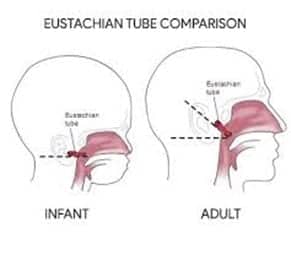Enlarged Adenoids Affect Your Hearing
Enlarged adenoids affect your hearing. When enlarged adenoids block eustachian tubes, fluids build up in your middle ear decreasing your ability to hear.
Need Help?
The Moore Auditory-Visual Observation Activity Booklet teaches you what to observe and how to observe helping you recognize visual processing difficulties. Schedule a free phone consultation with Cheri to share your story and learn how Cheri can help.
It is an honor to work with Cheri Moore on her journey with auditory integration therapy. She has shown a consistent desire to go above and beyond in every aspect of her practice and training. Cheri’s quest for greater understanding and her thirst for knowledge are demonstrated daily. It is a pleasure to work with a professional who is so eager to learn and apply new information to help her clients reach their best possible outcomes.
Kathy J Harvey-Jones, MsEd, Audiology, BC-HIS
Enlarged Adenoids and Hidden Difficulties
Enlarged adenoids contribute to many behaviors. Sometimes, behaviors are confused with attention deficit hyperactivity disorder. However, medication fails to improve attention because enlarged adenoids are still negatively affecting the person. A simplified explanation, enlarged adenoids interfere with breathing while asleep. While awake, they decrease how well someone hears. Both decrease attention. Researchers found that children, five to fourteen years of age, with enlarged adenoids have an increased risk of snoring, open-mouth breathing, and chronic congestion
Maintaining Benefits of Auditory Integration Training
The impact of enlarged adenoids is significant contributing to temporary, chronic hearing loss. Strong and consistent sound energy must stimulate the brain or sound intolerance distracts the listener.
Are enlarged adenoids contributing to diminished hearing negatively affecting your ability to listen with comprehension in all environments?
Due to wise advise from an ENT doctor, clients receive auditory integration training before surgery to strengthen auditory neural pathways improving tolerance of sounds. Removal of adenoids now allows strong sound energy to travel along auditory neural pathways to the brain. Auditory Integration Training is physical therapy for the hearing system and brain.
Full Impact of Snoring Caused by Enlarged Adenoids
When a child or teen snores, there are additional hidden concerns. Have you ever observed your loved one’s patterns of breathing while asleep. When a person briefly stops snoring, the person is most likely holding their breath. Lack of oxygen to the brain creates many of the behavioral characteristics shared below.
According to the Mayo Clinic, snoring is associated with numerous conditions.
Today, insurance companies require proof of the need to remove adenoids. When a sleep study test is not possible, schedule a phone conference to receive advocacy help.

Testimony: Life Changing Success of Hearing Aids for CAPD
My testimony: life changing success of hearing aids for Central Auditory Processing Disorder (CAPD) and mild hearing loss helped my granddaughter finally excel. I pray that my testimony: Life Changing Success of Hearing Aids for Central Auditory Processing Disorder...
How I Found My Joy After Losing Almost Everything
How I found my joy after losing almost everything to mold may provide insights to improve your emotional health: Joy, Peace, Forgiveness, Self-Acceptance, and Love. Writing this blog made me think about the grief children endure who constantly experience the struggles...
A Mother’s Journey Into the World of Auditory Dyslexia
During the spring of 2007, I attended Dianne Craft’s conference where I learned that dyslexia affects the auditory processing center and the visual processing center. Perhaps I had found help for my daughter’s reading and spelling struggles. She was a gifted artist,...
Why Falling to the Ground and Giggling Felt Great!
I wondered and wondered why falling to the ground and giggling felt great for my young son until I worked with Cheri. Together we solves this puzzle. After Cheri's success with helping my older son, I decided to seek her advice regarding my younger son’s unclear, loud...
5 Free Priceless Gifts From The Heart
Valentine's week and throughout the year 5 free priceless gifts from the heart helps you give a gift that is remembered and valued more than anything else. When the gift comes from the heart, it may be purchased or created by the giver. To create a bit of fun, try to...

While sleeping, does the person
- Breathe in a strange pattern
- Seem to stop breathing, gasp, cough, or choke
- Move often
- Wake up complaining their chest hurts
- Disturb covers until they are off the person
In the morning, does the person
- Wake up tired, grumpy, irritable
- Sound hoarse
- Need to cough up or spit out fluids
- Share their throat hurts
- Complain of a headache
During the day, does the person look
- Sleepy or falls asleep
- Absent-minded, daydreams, lacks attention
- Confused, unable to recall what just heard
- Irritated while listening and noise level increases
- Intense while trying to concentrate
Informed Decisions
When sleep studies are completed, parents are asked what they want to do. To make an educated decision, it is very important for parents to understand the full impact of enlarged adenoids.
Learn how the strength or weaknesses within your child’s hearing system is affecting the development of auditory processing skills and tolerance to sounds. I encourage you to complete a Moore Auditory-Visual Questionnaire, which provides you with a report sharing the intensity and frequency of behaviors associated with sound intolerance, hearing loss, auditory and visual processing difficulties. Overwhelmed? Schedule a FREE Phone Call.
Your Moore Auditory Visual Questionnaire Report helps you communicate with professionals advocating the importance of understanding behavioral impact of enlarged adenoids and medical test results.

Age & Eustachian Tube Position
When a person sleeps, enlarged adenoids block eustachian tubes. Thus, fluid builds-up in the middle ear. Depending on age and size of adenoids, the amount of fluid varies. In toddlers and preschoolers, the neck is short. As a result, eustachian tubes have a more horizontal position.
When fluid sits in eustachian tubes blocked by enlarged adenoids, bacteria grow. The end result, an increased risk of ear infections and inflammed eustachian tubes.
Hidden Concerns of Enlarged Adenoids While Awake
Enlarged adenoids create difficulties while the person is awake. Researchers found diminished hearing in research participants. Diminish hearing negatively affects attention, listening, learning, and emotional health.
Even more concerning, researchers found that research participants with enlarged adenoids were eight times more likely to experience four or more ear infections. In a different study, researchers found that chronic ear infections contribute to auditory processing difficulties, under-development in the brain.
Poor Eustachian Tube Health
Poor eustachian tube health is compounded when an individual with enlarged adenoids becomes sick. When sick, research participants experienced a greater degree of hearing loss for prolonged periods of time. Enlarged adenoids trap infected fluids irritating the lining of eustachian tubes.
After an ear infection is finally gone, decreased hearing difficulties continue. It can take another month to resolve inflammation in the eustachian tubes. Imagine the consequences when parents, teachers, and even the person affected are unaware of hearing loss explains learning difficulties, listening, and behaviors.
During infancy and toddler years, ear infections followed by healing of eustachian tubes can take two months. Consequently, auditory-visual-motor skills are at risk for developmental delays. Strong, consistent sensory stimulation to the brain is critical during the early years of brain development.
Distorted Sounds & Sound Intolerance
While children are awake, fluid drains out of eustachian tubes. Unfortunately, inflammation in the eustachian tubes requires consistent ear health during the day and night to resolve inflammation.
Sadly, chronic inflammation in the eustachian tubes distorts sounds. When chronic, under-stimulation of the brain increases the risk of sound intolerance and auditory processing difficulties.
Food Sensitivites & Allergies
Improve Your Health Blog, Six Foods Contributing to Inflammation of Eustachian Tubes
When a person has unknown food sensitivities or allergies, researchers found an increased risk of eustachian tube inflammation. Improve Your Health Blogs shares how to identify foods and steps to take towards improved ear health. Additional information is shared about the full impact of food sensitivities and allergies on the gut and brain.
As ear health improves, so does overall health. The result, some clients seem less irritable and more patient. A few clients experienced significant improvements in self-control and listening with comprehension.

Research Shows Negative Impact of Enlarged Adenoids
Haapaniemi (1995) found that participants with normal-sized to medium-sized adenoids experienced the behavioral characteristics below only 7% to 9.8% of the time while 25% (133 children) of 663 children, seven to 14 years of age, with enlarged adenoids experienced the following behavioral characteristics 14% to 30% of the time:
- Open-mouth breathing
- Snoring with first graders being the most affected age group
- Chronic congestion (blocked nasal pathway) also called sinusitis or rhinitis
- Decreased hearing by 1.1 to 4.2 decibels depending on size of enlarged adenoids
- Eight times more likely to have experienced four or more ear infections
Statistically significant differences between the two control groups showing an increased risk for decreased sound energy reaching the cochlea:
- Greater hearing loss during a common cold (.0003)
- Abnormal color and position of ear drum (tympanic membrane .0001)
- Lower pressure (60 to 70mm H2O) in the middle ear when compared to participants with typical-sized adenoids.
Summary
Overall, enlarged adenoids increase the risk of snoring contributing to decrease oxygen to the brain and decreasing the quality of sleep. Attention is negatively affected by fatigue and diminished hearing. The increased risk of ear infections negatively impact brain development. Researchers found that chronic ear infections disrupt development of auditory processing skills within the brain.

No Results Found
The page you requested could not be found. Try refining your search, or use the navigation above to locate the post.

Join Our Community!
Get tips on how to improve your health and learn through purposeful play delivered straight to your inbox.
